Identifying Toxomerus Hoverflies
Toxomerus is a distinctive genus of hover flies in the subfamily Syrphinae restricted to the Americas. It is a large genus, with 100-150 species described and probably many more undiscovered in the tropics. However, there are only a few species in North America. They are distinguished from other hover flies by their relatively small size, an indent in the back of their eyes, and unique abdomen markings.
(Out of date; please see the FlyGuide Toxomerus slides: https://sites.google.com/view/flyguide/species-guides/syrphidae/toxomerini)
Toxomerus in Canada and the United States
NOT Toxomerus
The most similar and often confused genus is Allograpta, which is of a similar size but lacks the pointed indent in the back of the eyes and has a distinctly different abdomen pattern.
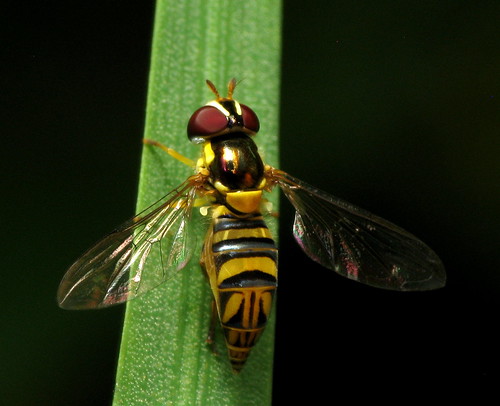
Female A. obliqua. Note the leaf-shaped spots near the end of the abdomen and the pair of vertical lines between them. These markings are found in both North American species of this genus.
Another genus sometimes mistaken is Sphaerophoria.
Northeast
In northeastern North America, there are 3 species of Toxomerus: T. marginatus, T geminatus, and T. politus
Margined Calligrapher (Toxomerus marginatus)
Margined Calligrapher is the most common species in North America. It is distinguished by having a thin pale line margin around the abdomen, which prevents any of the dark patterning from reaching the edge. It is smaller than the other common species. The abdomen pattern is composed of two sections of repeated bow-shaped dark areas surrounding a pale area, within which is a pair of comma-shaped dark markings. They have pale yellow legs, usually with little or no dark areas (especially on the femurs). The scutellum usually has a pale edge and a darker centre, which fade gradually into each other. Often it is entirely pale yellow.
This species is probably the most variable of the Toxomerus, but all of the above should stay true.

A fairly typical T. marginatus https://www.inaturalist.org/observations/1692571

This one has stronger black areas https://www.inaturalist.org/observations/5228078

This one has darker light areas https://www.inaturalist.org/observations/8190145

This one has paler dark areas https://www.inaturalist.org/observations/1372490
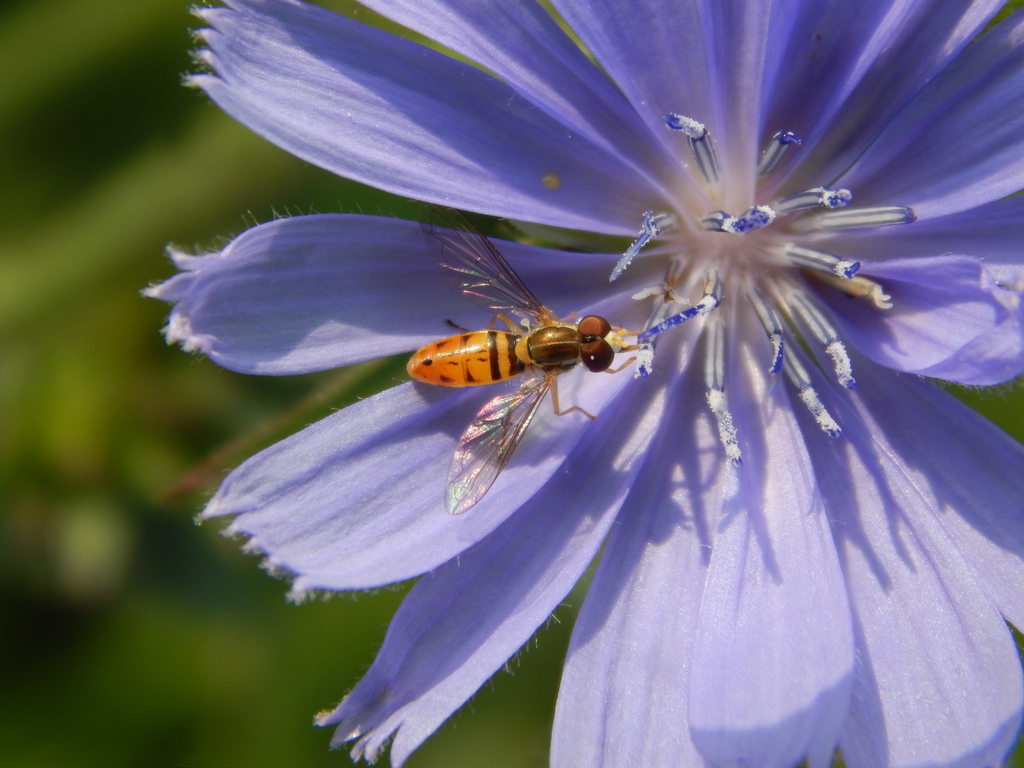
This one has reduced dark areas https://www.inaturalist.org/observations/2879458

View of legs and margin https://www.inaturalist.org/observations/4534930
It is possible, but rare, for there to be no dark or no pale areas left. That should give you a good idea of their variability. Other species are also variable, but the common species don't vary to the same extent. According to BugGuide, the colouration is based on the temperature that the pupa was exposed to. If it is cold, darker colours will develop, and if it is hot, paler colours will result.
Here's a cool photo showing one just before coming out of its pupa: https://bugguide.net/node/view/569812/bgimage
More photos: http://nathistoc.bio.uci.edu/diptera/Toxomerus.htm
Eastern Calligrapher (Toxomerus geminatus)
The Eastern Calligrapher is also a very common species in the east. When comparing it with Margined Calligrapher, the most obvious difference is that every aspect of the abdomen pattern is sharper and more pointed, with zig-zagged edges. Other distinguishing features are that the hind femurs will have a black ring around them, and the scutellum has a very dark centre with a yellow edge, and a sharp distinct line between the two (rather than gradual like in Margined Calligrapher).

https://www.inaturalist.org/observations/798049

A darker individual https://www.inaturalist.org/observations/1831242

Males are more tubular and their pattern is more obscured, but still visible https://www.inaturalist.org/observations/8189642

A pale individual https://www.inaturalist.org/observations/8680228

Darker with black in areas it usually isn't https://www.inaturalist.org/observations/11347511
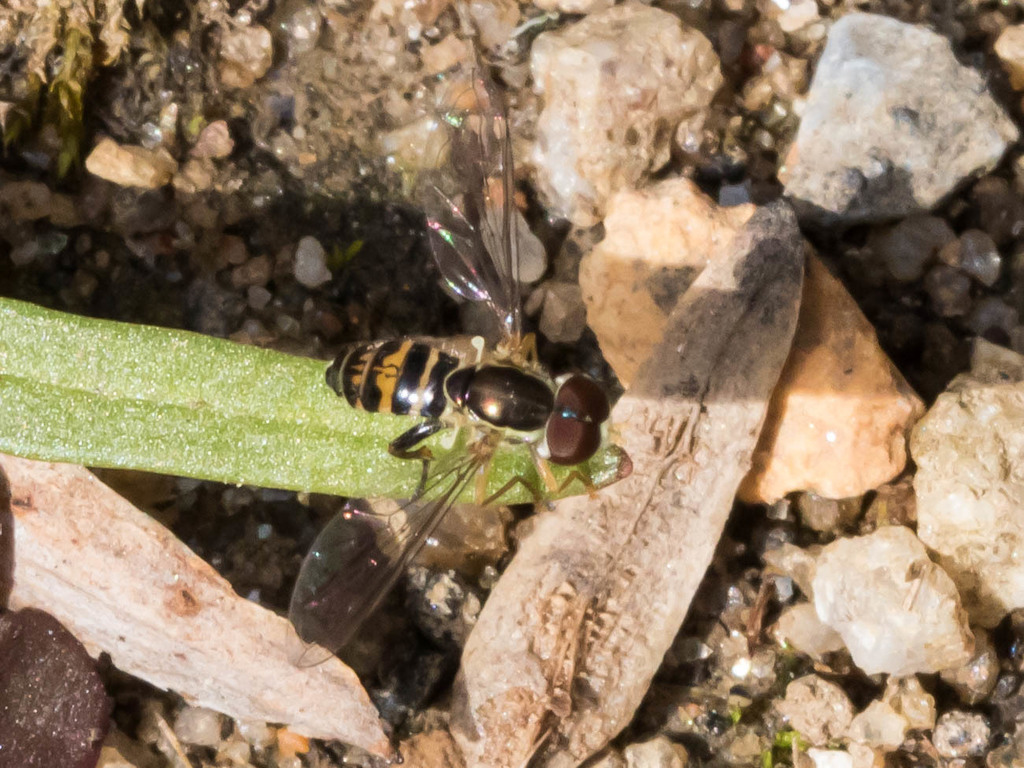
Much less jagged than usual with black missing from some spots it's usually present https://www.inaturalist.org/observations/11348608
Maize Calligrapher (Toxomerus politus)
Maize Calligrapher is a larger distinctive hover fly with a unique pattern, although sometimes it is confused with the Marmalade Hoverfly (Episyrphus balteatus) from Europe. It is much less common than the previous two species. It has a unique T-shaped pattern which should separate it from any other Toxomerus. In addition to that, it has a pale scutellum with a diffuse darker centre and pale legs, similar to Margined Calligrapher. The line in the centre of the scutum tends to be paler and more distinct than in other species.

https://www.inaturalist.org/observations/4016704
This species might have a unique abdomen pattern from any other species in the genus, and it ranges all the way down to Argentina.
West Coast
On the west coast of North America, there are only 2 species of Toxomerus: T. marginatus and T. occidentalis.
Western Calligrapher (Toxomerus occidentalis)
This species is in nearly all ways identical to Eastern Calligrapher, but is easy to separate by range. You can see a map here: https://bugguide.net/node/view/144390
A vagrant of either species outside of its range would probably be impossible to identify without a microscope (see Vockeroth, 382).
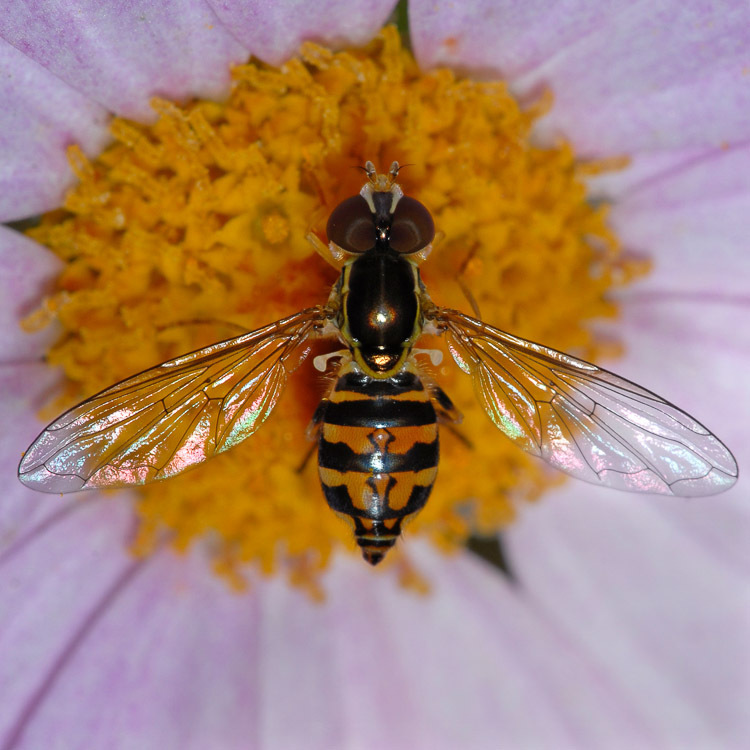
https://www.inaturalist.org/observations/905169

https://www.inaturalist.org/observations/8780308
Southeast
In the southeastern United States, there are at least 4 species, with the number increasing as you get closer to Florida. In addition to the three eastern species mentioned above, Thin-lined (or Bosc's?) Calligrapher is also common.
Thin-lined Calligrapher (Toxomerus boscii)
This species is less well known than the previous species, since it is restricted to the southeastern states. Its abdomen pattern is sort of halfway between that of Margined and Eastern Calligrapher, and is unique in having separated pairs of vertical lines on either side. It is usually reddish in colour, as opposed to the orange of Margined Calligrapher or yellow of Eastern or Western Calligraphers, although they can all vary. The main identifying features used on BugGuide are that "the yellow stripe on the mesonotum [along the side of the thorax above the wings] is not very thick and the hind femur has a black ring."

https://www.inaturalist.org/observations/4739888

https://www.inaturalist.org/observations/9534552
Florida has at least 10 species, some of which may be found in neighbouring states.
The list of species confirmed for Florida, from BugGuide, is: T. arcifer, T. boscii, T. corbis, T. dispar, T. floralis, T. jussiaeae, T. geminatus, T. parvulus, T. politus and T. marginatus
Many of these species come from the West Indies area, which has many more species.
Any photos of these species are only tentatively identified because the species in Florida are not very well known and there may be more species that haven't been confirmed for Florida.
Orange-backed Calligrapher (Toxomerus jussiaeae)
Has pattern similar to Margined Calligrapher, but the dark pattern reach the edge of the abdomen. The abdomen appear rounder and more egg-shaped, the dark bars are thinner and straighter, and the consecutive dark curved lines do not reach up to and touch the next set up. All photos I have seen so far show an entirely pale scutellum, with only a slightly dark centre.

Toxomerus jussiaeae? https://www.inaturalist.org/observations/6426951
More photos here: https://bugguide.net/node/view/1187795
Banded Calligrapher (Toxomerus verticalis)
This species has a relatively simple pattern, with repeated black and blue bands horizontal connected by a thin vertical black stripe.

Toxomerus verticalis? https://www.inaturalist.org/observations/8920762
More photos here: https://bugguide.net/node/view/1165326
Black-backed Calligrapher (Toxomerus parvulus)
There are photos of specimens here: http://scan-bugs.org/portal/collections/individual/index.php?occid=22824828
and here: https://mczbase.mcz.harvard.edu/name/Mesogramma%20parvula
Although they seem to contradict each other, so one of them may be misidentified?
There is a diagram of the abdomen here (fig. 72), which matches the second link: https://archive.org/stream/entomolog232419431944broo#page/n47/mode/2up
Florida and Dark-sided Calligraphers (Toxomerus floralis, dispar)
As far as I can tell, these hover flies are very similar to Margined Calligrapher, except without the margin. Thompson in "The Flower Flies of the West Indies" talks a lot about how dispar and floralis are inseparable. They are very variable like Margined.
Some more images here: https://www.researchgate.net/figure/Adult-female-Toxomerus-floralis-from-Calavi-Benin-A-dorsal-view-B-lateral-view-C_fig1_296086060

https://www.inaturalist.org/observations/10314295

https://www.inaturalist.org/observations/4032789

https://www.inaturalist.org/observations/9434785
More here: https://bugguide.net/node/view/636312/bgimage
and here: https://www.inaturalist.org/observations?lrank=genus&nelat=33.456651301881855&nelng=-70.66818237304688&place_id=any&quality_grade=research&subview=grid&swlat=22.824288902739497&swlng=-98.41964721679688&taxon_id=58753
And a couple here: https://bugguide.net/node/view/3277/bgimage
Hopefully summarizing what I understand this way will help us figure more out.
Bow-shaped Calligrapher (Toxomerus arcifer)
If it is possible to separate T. arcifer, it would probably be by the pattern on the base of the abdomen:

T. arcifer? https://www.inaturalist.org/observations/9846524
Notice the backwards pointing light-coloured pair of hooks, as compared to the straight pale bands in the previous photos. These are visible in diagrams of the abdomen in this species and not others (figs. 75a-75c, compare 91a-92): https://repository.si.edu/bitstream/handle/10088/21160/ent_FCT_43_4_.pdf#page=7
A couple more images here: https://www.instagram.com/p/Biz-Xt2noDm/
Unknown?
This individual does not match any of the abdomen diagrams or identified photos I have seen. There is a similar individual here: https://bugguide.net/node/view/1319797
Since they are in Florida, I would assume it is one of the 10 species listed on BugGuide, but I think I have found images or diagrams of all of them and it doesn't seem to match.
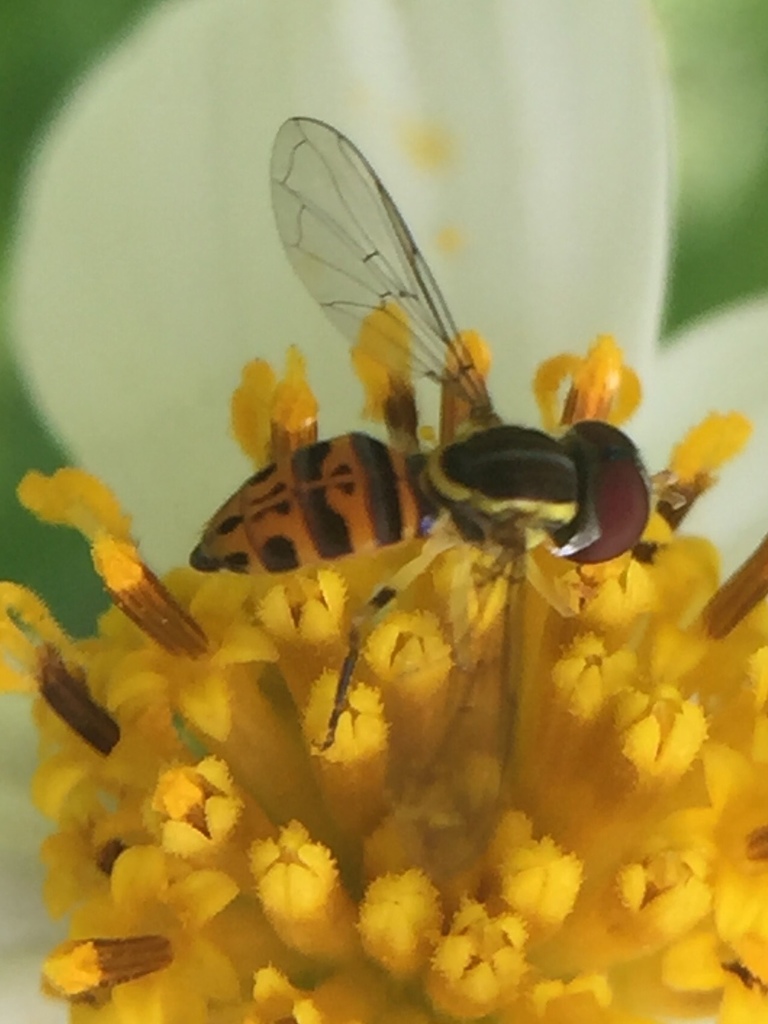
https://www.inaturalist.org/observations/7658734
Unknown?
I have not seen any photographed Toxomerus officially identified as T. corbis, but I am wondering if the observations listed here may be this species: https://www.inaturalist.org/observations/10310123
If so, this species is similar to T. watsoni from Mexico, with a mostly orange-abdomen. It has uncurved horizontal bands of black and blue, similar to T. verticalis, but it also has the pairs of comma-shaped markings in the centre like T. jussieae and other species.
A couple supposed specimens:
http://scan-bugs.org/portal/collections/individual/index.php?occid=22824854
https://mczbase.mcz.harvard.edu/name/Mesogramma%20planiventris

Toxomerus corbis? https://www.inaturalist.org/observations/10713367
Toxomerus in Central and South America
There are some websites or papers I have found that have photos or diagrams of many Toxomerus species, which may be helpful for identifying species further south. Based on old papers, the genus name used to be Mesogramma, which makes searching even more difficult than it already is.
Searching this database for the genus "Mesogramma" and "Mesograpta" results in photos of some species: https://mczbase.mcz.harvard.edu/SpecimenSearch.cfm (faster, same database: http://140.247.96.247/mcz/findrecords.php?-link=Find%20members)
There are quite a few photos of different species here: http://unibio.unam.mx/irekani/simple-search?query=toxomerus&rpp=25&sort_by=1&order=DESC&etal=0&submit_search=Update&proyecto=Irekani
More photos (I wonder if some of these may be misindentified): http://beta.boldsystems.org/index.php/TaxBrowser_Taxonpage?taxid=6466
And here (again, I wonder if some are misidentified): https://www.gbif.org/occurrence/taxonomy?media_type=StillImage&taxon_key=1534009
And here: http://syrphidae.inpa.gov.br/index.php/generos/syrphi?id=114
A few species: http://syrphidae.myspecies.info/taxonomy/term/148/media
A small number of photos lower down (sort by letter "T" first): https://diptera.info/photogallery.php?album_id=49
Searching for genus "Mesogramma" and "Toxomerus" gets a few images here (unfortunately many images don't work): https://research.amnh.org/iz/types_db/index.php / http://sci-web-001.amnh.org/imulive/iz.html
Also here (sort by Toxomerus and limit to specimens with images only): http://scan-bugs.org/portal/collections/harvestparams.php
There are many abdomen diagrams here, but they are liable to be outdated: https://archive.org/stream/entomolog232419431944broo#page/n37/mode/2up
Here is a filter for all the interesting Toxomerus that we still need to figure out: https://www.inaturalist.org/observations?place_id=any&subview=grid&taxon_id=58753&without_taxon_id=126889,126532,58752,146632,466380
Tips for species I have look into:
Clicking on the observations below each photo may yield more information about that species.
T. politus is relatively easy to ID and ranges from Canada all the way to Argentina. Tips for neotropical ID here: https://www.inaturalist.org/observations/8554152 The most similar species is T. aeolus.
People in Mexico seem to be pretty comfortable identifying Watson's Calligrapher (Toxomerus watsoni), but I don't know yet what the similar species in the area might be.
Many species look very similar to T. cf. duplicatus, with this simple pattern of horizontal bars and a pair of comma-shaped dots on a plain background. It is probably not possible to identify most of them to species.

https://www.inaturalist.org/observations/6306989

https://www.inaturalist.org/observations/5732239
More here: https://www.inaturalist.org/observations?field:Toxomerus%20identifiable%20group=T.%20cf.%20duplicatus
T. pulchellus seems to have a unique abdomen pattern, so it might be identifiable regardless of location. However, personally I would like to somehow first be confident that there are no similar species to eliminate. See: http://unibio.unam.mx/irekani/handle/123456789/26107?proyecto=Irekani
"Toxomerus pulchellus is easily recognized by the characteristic abdominal pattern in the female ... yellow with black bean-shaped spots on 3rd, 4th and 5th tergite" (Dumbardon-Martial, pg. 415)

T. pulchellus https://www.inaturalist.org/observations/11243614
T. pictus looks very similar to T. geminatus (which might be restricted to the US and Canada?) but can actually be separated by the length of the sharp black points on the abdomen, I think? As far as I can tell, T. croesus is the only species that looks the same, and Borges & Couri 2009 seems to suggest it is only found in southern Brazil.

T. pictus? https://www.inaturalist.org/observations/7428836
More here: https://www.inaturalist.org/observations?field:Toxomerus%20identifiable%20group=T.%20croesus/pictus
T. virgulatus might have a unique abdomen pattern?
https://diptera.info/forum/viewthread.php?thread_id=13523&pid=63012
https://www.youtube.com/watch?v=z9vZMq-m1oo
http://www.biofaces.com/specie/7421/toxomerus-virgulatus/

T. virgulatus https://www.inaturalist.org/observations/8714842
T. lacrymosus and musicus have a very unique pattern, but seem identical to each other and are inseparable as far as I can tell.

T. lacrymosus/musicus https://www.inaturalist.org/observations/5951808
More here: https://www.inaturalist.org/observations?field:Toxomerus%20identifiable%20group=T.%20lacrymosus%2Fmusicus
T. vertebratus seems to have a unique abdomen pattern. Good photo here: https://www.flickr.com/photos/sunerre1/38478445492

T. vertebratus http://www.ecoregistros.org/site/imagen.php?id=196964
T. saphiridiceps seems to have a unique abdomen pattern.

T. saphiridiceps https://www.inaturalist.org/observations/5898408
T. crockeri might be the only species on the Galapagos?
Other Resources
BugGuide page for Toxomerus: https://bugguide.net/node/view/3277
Common names are suggestions from this list, and aren't set in stone: http://www.canacoll.org/Diptera/Staff/Skevington/Syrphidae/Syrphidae_Nearctic_Checklist.htm
Vockeroth. The Flower Flies of the Subfamily Syrphinae of Canada, Alaska, and Greenland. 1992: http://esc-sec.ca/wp/wp-content/uploads/2017/03/AAFC_insects_and_arachnids_part_18.pdf
Upcoming Field Guide to the Syrphidae of Northeastern North America: http://www.canacoll.org/Diptera/Staff/Skevington/Syrphidae/Syrphidae.htm
Key to the Genera of Nearctic Syrphidae: http://cjai.biologicalsurvey.ca/mylmst_23/mylmst_23_551.HTM
Metz & Thompson. A revision of the larger species of Toxomerus. 2001: https://repository.si.edu/bitstream/handle/10088/17097/ent_FCT_91.pdf
Thompson, Chris. The Flower Flies of the West Indies. 1981: https://repository.si.edu/handle/10088/21160
Hull. The Genus Mesogramma. 1943: https://archive.org/stream/entomolog232419431944broo#page/n9/mode/2up
Borges & Couri. Revision of Toxomerus from Brazil. 2009: http://www.mapress.com/zootaxa/2009/f/z02179p072f.pdf
https://www.researchgate.net/publication/285700187_Revision_of_Toxomerus_Macquart_1855_Diptera_Syrphidae_from_Brazil_with_synonymic_notes_identification_key_to_the_species_and_description_of_three_new_species
Illustrated key for the genera of Syrphinae (Diptera, Syrphidae) of occurrence in the South of Brazil: http://www.scielo.br/scielo.php?script=sci_arttext&pid=S1676-06032007000100019&lng=em&nrm=iso&tlng=em
This website is helpful for finding taxonomic synonyms:
http://insectoid.info/insecta/diptera/syrphidae/toxomerus_genus/
http://insectoid.info/insecta/diptera/syrphidae/mesogramma_genus/
Gerdes. Notes on Types of Toxomerus. 1975. https://archive.org/stream/biostor-77448#page/n0/mode/2up
Gerdes. A New Species of Ecuadorean Toxomerus. 1974. https://archive.org/details/biostor-77477
Gerdes CF. (1974) Toxomerus (Diptera: Syrphidae) of Ecuador. Masters thesis, Western Illinois University, 135 pp. (has only the same abdomen diagrams as the above two papers but descriptions of many species)
Harbach. A New Species of Toxomerus from Brazil, with Notes on Three Related Species. 1984. https://www.researchgate.net/publication/266593917_A_new_species_of_Toxomerus_Diptera_Syrphidae_from_Brazil_with_notes_on_three_related_species
Image of T. apegiensis (from Reemer and Rotheray, 2009). https://www.researchgate.net/figure/Adult-male-of-Toxomerus-apegiensis_fig6_233206830
Quite a few great image, most not identified past genus unfortunately: https://diptera.info/search.php?stext=toxomerus&search=Search&method=OR&forum_id=0&stype=all&datelimit=0&fields=2&sort=datestamp&order=0&chars=50
Dumbardon-Martial. Pollen feeding in the larva of Toxomerus pulchellus. 2016.
Mengual. Black-tie dress code: two new species of the genus Toxomerus. 2011. https://zookeys.pensoft.net/article/2850/
Thompson & Thompson. A new Toxomerus species from Chile. 2006. https://repository.si.edu/bitstream/handle/10088/4385/Thompson_Thompson2007.pdf
Thompson, Vockeroth, Sedman. A Catalogue of the Americas South of the United States: Family
Syrphidae. 1976. https://archive.org/details/familysyrphidae00thom/page/46 (just a list of all the Toxomerus species)
Reemer. A second survey of Surinam Syrphidae: introduction and Syrphinae. 2010. (comments and photos of specimens of a number of species)
No images but some descriptions and helpful information:
Marín-Armijos et al. Checklist of the flower flies of Ecuador. 2017. https://www.zfmk.de/dateien/dokumente/2017_ecuador_checklist_0.pdf
Hull. New species of Mesogramma. 1951. https://digitallibrary.amnh.org/handle/2246/2363
Hull. New Species of Syrphidæ From the Neotropical Region. 1942. https://www.hindawi.com/journals/psyche/1942/062725/citations/
Catalogue of Syrphidae of Colombia (Montoya, 2016) https://www.researchgate.net/publication/303958998_Family_syrphidae (Toxomerus starts page 480)
Marín-Armijos et al. Checklist of the flower flies of Ecuador. 2017. https://www.zfmk.de/dateien/dokumente/2017_ecuador_checklist_0.pdf
Draft index to abdomen diagrams:
https://docs.google.com/spreadsheets/d/10YlrEnvpBdu2HhbdoP7VSysL1sOTUre6tXzJ0TdLOhw
Photo list of species identified on iNat: https://www.inaturalist.org/observations?taxon_id=58753&view=species
Observation field for Toxomerus that are currently unidentifiable: https://www.inaturalist.org/observation_fields/8909
I have also made a Flickr gallery which has quite a few Toxomerus photos: https://www.flickr.com/photos/7_ate_9/galleries/72157695607420574/
There are a lot of great photos on Flickr which haven't been added to iNat.
I would appreciate any corrections or suggestions for improving this guide. Thanks!





